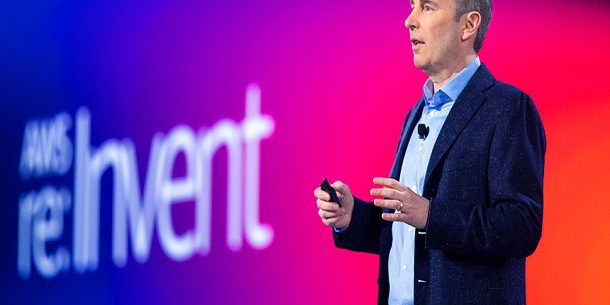
Kết lại AWS re: Invent 2020

Binh Nguyen
Head of DevOps
Mục lục
Năm nay, AWS re: Invent được tổ chức online và miễn phí. Nhưng cũng như mọi năm, các developer, kiến trúc sư, và tất cả mọi người đều phải đối mặt với thử thách. Là lựa chọn nội dung re: Invent.
Vì vậy, sau khi chọn lọc sau đây là những nội dung mà tôi thấy thú vị nhất. Từ compute, database và storage, machine learning. Hy vọng rằng bạn sẽ nhận được nhiều sự hữu ích từ danh sách này!
1. Compute
Trong ngày đầu tiên của hội nghị, Amazon đã công bố EC2 Mac instance cho macOS, sau nhiều năm bổ sung một hệ điều hành mới cho EC2. Mục đích là nhắm vào các quy trình chỉ chạy trên Mac OS. Như xây dựng và thử nghiệm các ứng dụng cho iOS, MacOS, tvOS và Safari. Phần đầu tiên trong bài phát biểu của Andy Jassy tập trung vào các thông báo liên quan đến các tùy chọn máy tính và serverless. AWS đã giới thiệu các loại phiên bản mới trên các bộ xử lý và họ EC2 khác nhau. Bao gồm phiên bản Intel Xeon M5zn, phiên bản C6gn hỗ trợ Graviton2, phiên bản D3 / D3en hỗ trợ Intel. Phiên bản R5b được tối ưu hóa bộ nhớ và phiên bản GPU G4ad hỗ trợ AMD.
Theo tôi, khả năng chạy các phiên bản Mac trên public cloud thật thú vị. Lợi ích lớn nhất sẽ dành cho các công ty phần mềm xây dựng ứng dụng iOS. Bây giờ họ có thể kiểm tra trực tiếp trên AWS bất kỳ lúc nào mà không cần phải mua và bảo trì phần cứng. AWS mang lại lợi thế lớn cho việc phát triển đa nền tảng. Đối với nhà phát triển cá nhân, người đam mê công nghệ. Đây là một cách hiệu quả về chi phí để thử các tập lệnh và chương trình sẽ chạy như thế nào trên nền tảng Mac.
Lambda và serverless
Billing granularity giảm từ 100ms xuống 1ms sẽ giúp giảm chi phí cho mỗi Lambda đơn lẻ. Ngoài ra, bộ nhớ lên đến 10 GB và 6 vCPU cũng được thêm vào. Một tính năng mới nữa là hỗ trợ đóng gói hình ảnh. Để đơn giản hóa việc chuyển đổi từ workloads dựa trên container hiện tại sang serverless.
Theo tôi, điều này giúp tiết kiệm được một lượng lớn chi phí. Một số khách hàng sử dụng rất nhiều hàm Lambda nhỏ và đơn giản hoàn thành trong vài mili giây. Trước đây, ngay cả đối với chức năng nhỏ nhất, chi phí tối thiểu là 100ms. Giờ đây, khi chỉ số mili giây thực tế được lập hóa đơn, sẽ giúp khách hàng giảm đáng kể chi phí.
Thêm Amazon ECS Anywhere và Amazon EKS Anywhere
Container orchestration software được sử dụng trong ECS và EKS sẽ được triển khai bên ngoài AWS, trên các nhà cung cấp đám mây khác. Điều này giúp khả năng tích hợp tăng lên và độ trễ thấp hơn. Đồng thời sẽ đi theo con đường của Microsoft và Google, cung cấp Azure AKS và Google Anthos miễn phí.
Theo tôi, điều này đưa AWS ngang hàng với các nhà cung cấp public cloud lớn khác khi nói về dịch vụ Kubernetes. Vì EKS hiện có thể được chạy bên ngoài AWS, nó sẽ giúp khách hàng sẵn sàng hơn để áp dụng nền tảng này. Vì họ không phải lo lắng về việc bị khóa dịch vụ nữa. Dịch vụ cung cấp tiềm năng thậm chí hấp dẫn hơn là ECS Anywhere. Với ECS, khách hàng điều phối container hiệu quả mà không cần đến sự phức tạp của Kubernetes. Trước đây, ECS chỉ có thể chạy trên AWS. Do đó, hạn chế việc áp dụng, nhưng giờ đây, nhiều khách hàng sẽ coi nó như một tùy chọn tiềm năng.
AWS Proton
Một dịch vụ triển khai được quản lý mới cho các ứng dụng container và serverless đã được công bố. Với AWS Proton, khách hàng có thể tự động hóa và quản lý việc cung cấp cơ sở hạ tầng, triển khai code cho các ứng dụng serverless và dựa trên container. ECR Public Repositories là nơi tạo container công khai để lưu trữ, quản lý, chia sẻ và triển khai trên toàn cầu.
Theo tôi, ECR Public Repositories giúp dễ dàng chia sẻ các dịch vụ được đóng gói. Nó giúp chia sẻ phần mềm nguồn mở cho cộng đồng để mọi người cùng hưởng lợi.
2. Storage
Có 3 thông tin chính dành cho EBS, dịch vụ block storage được thiết kế cho EC2. Đầu tiên, loại EBS gp3 mới rẻ hơn 20% so với loại gp2 trước đó. Nhưng cung cấp hiệu suất cơ bản cao hơn. Và đây là ổ đĩa chung đầu tiên cho phép định cấu hình IOPS độc lập với disk size.
Theo tôi: Chúng ta không cần phải nghi ngờ gì nữa, gp3 mới cho EBS là một cải tiến tuyệt vời. Hãy thử và chuyển đổi gp2 sang gp3 ngay bây giờ.
io2 Block Express mới
io2 Block Express mới hỗ trợ high-IOPS với kích thước nhỏ. Hãy xem ngay giá IOPS cho io2 đã được áp dụng.
S3
Cập nhật chính cho lưu trữ đối tượng S3 là tính nhất quán cho phép đọc-sau-ghi tự động cho tất cả các ứng dụng. AWS cũng công bố các cải tiến khác cho S3, bao gồm sao chép với nhiều bucket. Sao chép hai chiều giữa các khu vực để cải thiện hỗ trợ cho các ứng dụng đa vùng và đa vùng và các khóa nhóm mới.
Theo tôi: Tính nhất quán mạnh mẽ của S3 là một trong những cải tiến kỹ thuật chính nổi bật của sự kiện re: Invent này. Nó loại bỏ sự lo lắng về các lỗi phổ biến có thể xảy ra khi một ứng dụng cố gắng đọc một đối tượng S3 ngay sau khi nó được cập nhật nhưng vẫn nhận một phiên bản cũ. Tính đồng nhất cho phép ứng dụng đọc sẽ luôn nhận được phiên bản mới nhất.
3.Cơ sở dữ liệu
Babelfish cho Aurora, một lớp dịch ngôn ngữ cho Amazon Aurora PostgreSQL. Cho phép Aurora hiểu các lệnh từ các ứng dụng được viết cho Microsoft SQL Server. Aurora Serverless v2 là một cơ sở dữ liệu serverless relational mới. Tương thích với MySQL và AWS Glue Elastic Views, xây dựng các khung nhìn cụ thể hóa để kết hợp và sao chép dữ liệu trên nhiều kho dữ liệu. Amazon Aurora PostgreSQL hiện tích hợp với AWS Lambda.
Amazon Redshift
Các cải tiến khác nhau và các tính năng mới đã được giới thiệu cho Amazon Redshift, dịch vụ kho dữ liệu. Chẳng hạn như khả năng di chuyển các cluster giữa các avalability zones, tối ưu hóa bảng tự động, chia sẻ dữ liệu và hỗ trợ xử lý dữ liệu JSON gốc.
Theo tôi: Năm nay, AWS không công bố bất kỳ sản phẩm cơ sở dữ liệu mới nào. Điều này không giống như hầu hết các sự kiện re: Invent trước đó. Tuy nhiên, những cải tiến từ năm nay giúp các công ty và DBA làm việc hiệu quả hơn với dữ liệu từ nhiều nguồn. Điều này đặc biệt hữu ích đối với các doanh nghiệp sử dụng nhiều loại lưu trữ dữ liệu khác nhau. Với các tính năng mới, việc hợp nhất dữ liệu kinh doanh từ các nền tảng khác nhau thành một data lake hoặc data warehouse duy nhất trở nên khả thi và tiết kiệm chi phí hơn.
3. Mạng lưới và IoT
AWS Local Zones, phần mở rộng các vùng nằm gần các khu vực đông dân cư để cung cấp độ trễ thấp hơn, đã được giới thiệu vào năm 2019. Trong hội nghị, AWS thông báo rằng ba Local Zones mới sẽ là GA trong tháng này tại Boston, Houston và Miami. Và thêm mười hai vào năm 2021, bao gồm cả Thành phố New York và Chicago.
Các tùy chọn Outpost nhỏ hơn cũng sẽ được áp dụng vào năm tới. Cho phép khách hàng triển khai phần cứng AWS trong các văn phòng, nhà máy. Và địa điểm nhỏ hơn bị hạn chế về không gian nhưng cần quyền truy cập vào khả năng tính toán có độ trễ thấp.
Về IoT, AWS IoT Greengrass 2.0 mới cung cấp mã nguồn mở và các công cụ để phát triển phần mềm cục bộ. Đồng thời quản lý phần mềm trên các nhóm thiết bị lớn.
Theo tôi: Đối với Việt Nam và phần còn lại của Đông Nam Á, trọng tâm chính nên là IoT và hỗ trợ cạnh biên tốt hơn. Phiên bản thu nhỏ của Outpost sẽ làm cho sản phẩm này trở nên hấp dẫn hơn đối với khách hàng Việt Nam. Và chúng tôi kỳ vọng sẽ có các dự án thử nghiệm đầu tiên của Outposts tại Việt Nam và các thị trường Đông Nam Á khác trong vòng một năm.
4. Machine Learning
Nhiều tính năng và sản phẩm mới của machine learning đã được thảo luận trong bài phát biểu của Swami Sivasubramanian, phó chủ tịch phụ trách AI và machine learning tại AWS. Trong đó, tập trung vào SageMaker. Amazon SageMaker Feature Store mới là một kho lưu trữ được quản lý hoàn toàn. Xây dựng có chủ đích lưu trữ, cập nhật, truy xuất và chia sẻ các tính năng machine learning.
SageMaker Clarify, SageMaker Debugger, SageMaker Managed Data Parallelism và SageMaker Model Parallelism là những dịch vụ và tính năng mới khác được công bố.
AWS Trainium
AWS Trainium, một machine learning training chip. Được thiết kế bởi AWS và Habana Gaudi trên EC2. Đã được công bố vào đầu hội nghị. Cùng với Amazon Monitron, một hệ thống end-to-end phát hiện hành vi bất thường trong máy móc công nghiệp. Và AWS Panorama, một thiết bị machine learning và SDK.
Amazon Lookout for Metrics
Amazon Lookout for Metrics là một phần bổ sung nữa trong lĩnh vực phát hiện bất thường. Bổ sung thêm một dịch vụ linh hoạt để phân tích chuỗi thời gian. Cùng với Amazon Lookout for Equipment và Amazon Lookout for Vision.
Theo tôi: Machine learning đang mở rộng đáng kể. Nhiều giải pháp chuyên biệt hơn sẽ được tung ra thị trường. Tất cả các bản phát hành mới từ AWS đều nhắm mục tiêu tới các trường hợp sử dụng cụ thể. Đối với các công ty đã có kinh nghiệm về các dự án AI / ML rất đáng để khám phá. Còn đối với những người vẫn chưa quen với machine learning, thì chắc phải chờ đợi trong vài tháng. Vì AWS nhận ra thách thức của việc có quá nhiều tùy chọn dịch vụ để lựa chọn. Và chắc chắn sẽ đưa ra một giải pháp giúp đơn giản hóa việc bắt đầu.
5. Giám sát, Kiến trúc và Mã hóa
Một phần trong bài phát biểu của Werner Vogels dành riêng cho tầm quan trọng của việc logging, giám sát và cải thiện việc triển khai. Hiện đã có một số dịch vụ và cải tiến mới: CloudTrail cung cấp khả năng kiểm soát chi tiết hơn đối với việc ghi nhật ký sự kiện dữ liệu. Trong khi Amazon Managed Service cho Prometheus (AMP) và Amazon Managed Service cho Grafana (AMG) hiện đang ở dạng xem trước.
Chúng tôi tin rằng khả năng hiển thị tốt hơn về cách ứng dụng và cơ sở hạ tầng đang hoạt động. Là điểm khác biệt chính để hỗ trợ chất lượng phần mềm và dịch vụ doanh nghiệp. Do đó, tất cả các cải tiến cho công cụ giám sát AWS đang trực tiếp mang lại lợi ích đến quy trình kinh doanh của bạn. Năm nay, trọng tâm đặc biệt là giúp Kubernetes dễ hiểu hơn. Việc công bố Dịch vụ được quản lý AWS cho cả Prometheus và Grafana. Có nghĩa là việc giám sát triển khai Kubernetes trong EKS và các nền tảng khác đang trở nên được tổ chức tốt và đơn giản hơn.
AWS Fault Injection Simulator
AWS Fault Injection Simulator là một dịch vụ kỹ thuật được quản lý sẽ ra mắt vào năm 2021. Sẽ được giới thiệu giữa một loạt các dịch vụ AWS, bao gồm EC2, EKS, ECS và RDS.
Theo tôi: Khi các công ty chuyển dần qua nền tảng đám mây nhiều hơn. Và thích ứng với tư duy tiếp cận chủ động để đạt được độ tin cậy và ổn định. Các phương pháp chaos engineer trở nên phổ biến. Khi bạn đưa các sự kiện gián đoạn ngẫu nhiên vào hệ thống của mình. Chẳng hạn như đột ngột tắt một phiên bản, bạn có thể kiểm tra cách hệ thống của mình phục hồi sau những lỗi như vậy một cách dễ dàng. Với dịch vụ chaos engineer được quản lý từ AWS, có thể tổ chức, giám sát tất cả trong một dịch vụ để có kết quả tốt hơn.
Cloudshell
Cloudshell, trình duyệt có thể tương tác với các tài nguyên AWS, đã có sẵn. Giúp làm việc với CLI đơn giản hơn mà không cần chạy một instance và xử lý thông tin xác thực. Python hiện được hỗ trợ bởi Amazon CodeGuru, dịch vụ được quản lý để đánh giá mã tự động và đề xuất hiệu suất ứng dụng. Amazon Location, một dịch vụ tích hợp bản đồ, nhận biết vị trí và các tính năng dựa trên vị trí khác vào các ứng dụng web và di động đã được công bố trong bản xem trước vào cuối hội nghị.
Theo tôi: Cloudshell là một trong những sản phẩm thú vị nhất từ AWS dành cho các kiến trúc sư giải pháp đám mây. Những người hiện có thể truy cập shell và CLI trực tiếp từ bảng điều khiển AWS. Điều này giúp việc chạy các tập lệnh của chúng tôi nhanh hơn nhiều và cải thiện năng suất trong công việc hàng ngày với các dịch vụ AWS. Mặc dù Cloudshell ban đầu chỉ khả dụng ở khu vực Châu Âu và Hoa Kỳ, chúng tôi hy vọng AWS sẽ bổ sung nó ở khu vực Singapore trong thời gian ngắn. Sau đó khách hàng Việt Nam cũng có thể hưởng lợi từ điều này.
Chúng tôi xin mời mọi người quan tâm về các đợt ra mắt sản phẩm AWS mới và các phương pháp hay nhất cùng tham gia vào buổi re: Invent tháng 1 năm 2021 tại Thành phố Hồ Chí Minh và Hà Nội theo thông báo của AWS.
Nguồn:



